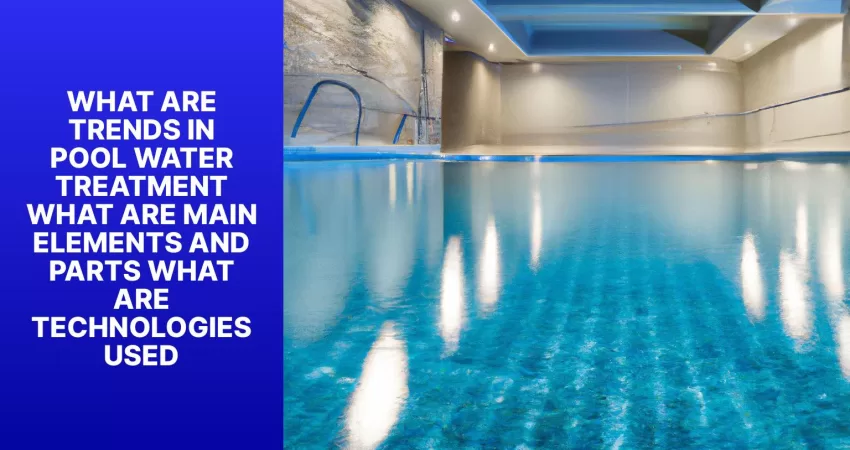- August 15, 2023
- admin
What are Trends in Pool Water Treatment?
Pool water treatment tech is always advancing. It’s key to understand the elements and parts. Filtration, disinfection, and pH balance maintenance are the primary components. Filtration systems clear away particles, debris, and contaminants. Disinfection methods (like chlorination or ozonation) eliminate harmful bacteria.
Advanced techs like ultraviolet (UV) disinfection are used for pathogen control without chemicals. And electro chemical oxidation combines chlorine with saltwater to produce powerful oxidants that kill microorganisms. Automated monitoring systems track pH levels, sanitizer levels, and temperature.
The need for proper pool water treatment is due to potential health risks. According to the CDC, inadequate treatment can result in recreational water illnesses (RWIs). Research and development keeps moving towards safer and more sustainable practices. Pool owners should stay informed to ensure enjoyment and health and safety for all swimmers.
Trends in Pool Water Treatment
Pool water treatment has advanced significantly recently, to provide clean and safe environments for swimming. Technologies and systems are used to tackle the issues with water quality. The following table explains the trends:
| Trend | Main Elements | Technologies Used |
| Automation | Automated monitoring and control systems | Remote sensing technology |
| Water conservation | Efficient filtration and recycling methods | UV disinfection systems |
| Improved sanitation | Advanced disinfectants | Ozone generators |
| Energy efficiency | Solar heating systems | Variable speed pumps |
Automation is vital for pool water treatment. It enables monitoring and control of e.g. chlorine levels, pH balance and temperature. This means no manual work is needed.
Water conservation is also a key trend. Filtration systems remove impurities and recycling helps reduce wastage. UV disinfection can replace chemicals.
Improved sanitation, such as ozone generators, are effective and reduce chemical usage. Ozone is an oxidizing agent that breaks down organic matter and kills pathogens.
Energy efficiency is important for pool maintenance. Solar heating systems use renewable energy to heat pools, and variable speed pumps can adjust flow rates according to demand.
To stay up-to-date with trends in pool water treatment, explore new technologies and systems. Don’t miss out on better safety, cleanliness and efficiency. Embrace these trends now for a great swimming experience later.
Main Elements and Parts of Pool Water Treatment Systems
Pool water treatment systems have crucial components that work together to keep swimming conditions clean and safe. Let’s explore them!
We can classify the main elements and parts into several categories, such as filtration, disinfection, circulation, and monitoring. Every part has a vital role in keeping the water quality high.
For example, Sand Filters remove debris and particles; Cartridge Filters catch impurities with pleated filter material; DE Filters use diatomaceous earth for tiny particles; Chlorinators release chlorine to kill viruses; UV Sterilizers use ultraviolet light to eliminate bacteria; Ozonators create ozone gas for sanitation; Pumps move water through the filtration system; Valves control the flow of water; pH Meters measure acidity/alkalinity; ORP Controllers monitor oxidation-reduction potential.
Additional components may be present depending on the pool’s needs. For instance, Heat Exchangers regulate water temperature and Automatic Dosing Systems ensure chemical dosage.
By understanding these components, we understand how pool water is treated. It’s important to maintain a well-functioning system for a hygienic environment.
Take action to keep your pool water clean and safe. Invest in pool water treatment systems to enjoy swimming confidently with no health risks. Act now and make a splash!
Technologies Used in Pool Water Treatment
Pool water treatment needs advanced tech for clean and safe swimming. Chlorine generators turn salt into chlorine, so no manual chemicals needed. UV disinfection uses UV light to kill germs. Ozone generators produce ozone to get rid of contaminants. Sand filters trap debris for clear water.
To optimize pool water treatment:
-
- Monitor parameters like pH, chlorine and clarity.
-
- Automate chemical dosing, filtration and other processes.
-
- Get energy-efficient pumps, filters and heaters.
-
- Follow manufacturer maintenance guidelines.
These steps will make for a great swimming experience!
Conclusion
Pool water treatment is ever-evolving. From filtration systems to UV disinfection, the industry is always finding innovative ways to keep it clean and safe.
Filtration systems are designed to remove particles as small as 1 micron. This improves clarity and reduces the need for chemicals.
UV disinfection is great for killing bacteria and viruses. It’s an ideal way to maintain cleanliness without using harsh chemicals.
Eco-friendly solutions are becoming popular. Ozone and saltwater chlorination are better for the environment than traditional chlorine-based treatments. They are effective and minimize chemical additives.
It’s important to stay informed of new trends and technologies. Embrace new filtration methods and explore alternative disinfection techniques. This will ensure a safe and enjoyable swimming experience.
Stay up-to-date with advancements in pool water treatment. Take advantage of these developments to provide swimmers with an exceptional aquatic experience.
